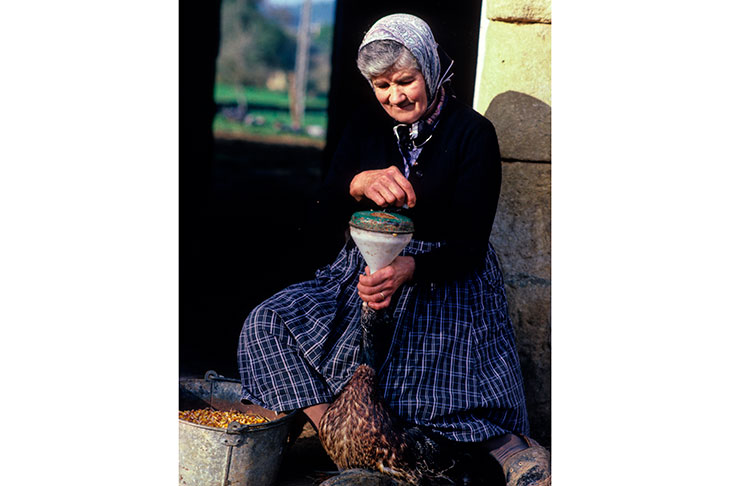In his excellent, brief chronicle of foie gras, Norman Kolpas lists Kate Winslet, Ralph Fiennes, Thandie Newton, Ricky Gervais and the late Sir Roger Moore as among those who don’t want you to eat it, as well as Fortnum & Mason and the state legislature of California, which declared its production and sale illegal in 2019. Why do they care about something so petty as the making and consumption of this buttery, savory age-old delicacy? There is, of course, a hint of class warfare about advocating its prohibition, along with caviar and other treats of the well-off and indulgent. But the main opposition claim is that the production of the hyper-fatty livers of ducks and geese is physically cruel and therefore immoral.
The factual argument is just plain wrong, and so is the ethical judgment that depends on it. I have witnessed the ‘force-feeding’ of ducks, and it is not a case of animal abuse. What actually happens is that the nicely behaved ducks (imprinted à la Konrad Lorenz) form an orderly line to take their turn swallowing a flexible tube that in seconds whooshes pellets of maize or mash of cereal down their gullets. They appear to relish this, and are, in my experience, fussed about and petted affectionately by the farming women of the south-west of France who perform what is called the gavage.
The problem, says Norman Kolpas, is that our celebrities and anti-foie gras activists ‘immediately and understandably tend to anthropomorphize the birds, imagining how it might feel for a human to have a feeding tube jammed down the throat’. This image of oral rape comes from an ignorance of bird physiology. The human esophagus is a more rigid structure of muscle, cartilage and bone, and inserting a tube down it means getting past the epiglottis, which triggers the human gag reflex. These waterfowl species do not have a gag reflex.
The gavage, in fact, mimics the birds’ natural pre-migratory behavior; following the seasons, they gorge themselves with food in preparation for their long flights. This had been remarked at least as early as 400 BC, when, says Kolpas, ‘well-fattened geese were deemed sufficiently worthy to be presented as a gift when Agesilaus, king of Sparta, visited Egypt’. The Greeks and Romans force-fed geese with figs rather than grain, a practice later adapted for rich pork liver, as recommended by Apicius. Foie gras found its way to south-western France with the conquest of Gaul (121-51 BC), and then Jewish slaves, cooks and farmers spread it east across Europe. Though goose makes the most appreciated fat liver, the amount of goose foie gras now produced globally has become minuscule (about 5 percent) compared with duck foie gras, mostly from (pond-shunning) hybrid male Moulard ducks, whose meat is also succulent and valued.
Why, then, do we still have anti-foie gras hysteria? It is true that force-fed ducks may find it more difficult to waddle around the farmyard in their last liver-expanded days; but though it’s obvious that force-feeding causes an abnormal swelling of the liver, it’s not evident that pain is being inflicted. In normal artisanal conditions, the birds are confined for the last days in barns or smaller units, both for convenience and efficiency, but avian social distancing is respected, if only for reasons of hygiene. The scare stories, and long-discredited photographs of geese with their feet nailed to the floor, are mere mischief-making. The point of gavage is to get the birds to gain weight; mistreating them puts them off their food.
Most foie gras comes from France. Exports decreased recently because of bird flu. There seem to be some alternative production methods to gavage, for example, the farm in Extremadura that deceives the birds into stuffing themselves to prepare for migration. The high-end British supermarket Waitrose has sold goose liver ‘faux gras’, and there is a product branded Foie Royale that involves a little chemical tinkering with the texture. A US foie gras farm in the Hudson Valley says its uncaged birds are treated so benignly that visitors are encouraged to take photographs. It’s difficult to find figures, but it appears that even the Chinese have so far failed to industrialize foie gras production, and that it remains an artisan-produced food. In the nasty world of cheap, intensively farmed chickens and eggs, punishing foie gras producers looks like a truly trivial pursuit.
Kolpas could have been a little more discriminating by distinguishing the greater delicacies, cooked whole or uncooked fresh foie gras, from the much more common pâté de foie gras, which can consist of 50 percent or less of the real thing. As for foie gras class war, we’ll have to leave that to English speakers: foie gras was enshrined by the inheritors of the French Revolution as part of their patrimoine culturel et gastronomique in 2005, and remains a delicious aspect of France’s democratic celebrations of Christmas and the New Year.
This article was originally published in The Spectator’s UK magazine. Subscribe to the World edition here.

























